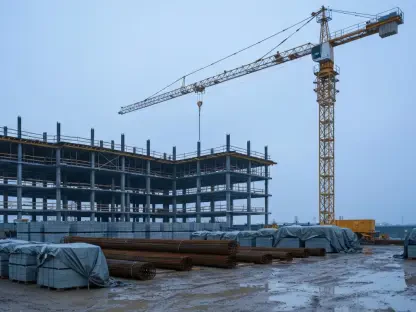The escalating costs of infrastructure projects are proving to be a significant challenge for small cities across the United States. The City of Cold Lake serves as a prime example of this struggle, as the budget for its new Public Works Operations Centre has risen dramatically from an initial estimate of $32 million to a staggering $55 million. This case highlights the financial strain municipalities face when embarking on substantial infrastructure endeavors amidst a backdrop of rising construction costs, market fluctuations, and unpredictable economic conditions. Additionally, tariffs and other external economic pressures contribute to the complexities municipalities must navigate to fund essential projects.
The Vision for Public Works Operations Centre
The Public Works Operations Centre represents an ambitious project designed to centralize numerous public works activities within a single 50,000-square-foot facility on a 40-acre site. The center will house fleet maintenance bays, transit bays, departmental shops, a wash bay, a stormwater pond, and accommodate 70 parking stalls. Initially budgeted at $32 million, the original financial plan has since proven insufficient due to a combination of inflation and shifting market forces that have significantly driven up construction costs. The undertaking spans several council terms, reflecting a long-term vision to better organize and streamline the city’s public works efforts.
City officials acknowledge the obstacles posed by these rising costs. Mayor Craig Copeland and Chief Administrative Officer Kevin Nagoya have both articulated the necessity of borrowing funds to cover the unexpected financial gap. The approved borrowing bylaws now include $8.5 million allocated specifically to complete the Public Works Operations Centre, part of the $23 million in loans issued over the past few years. This borrowing has been essential to advancing the project and addressing the immediate financial demands. Despite these measures, the overarching financial landscape remains challenging, emphasizing the high stakes and careful financial stewardship required.
Funding Sources and Financial Implications
The broader implications of increased project costs extend beyond the immediate financial challenges. Mayor Copeland has underscored that municipalities like Cold Lake receive minimal financial support from provincial and federal governments relative to their extensive needs. With Cold Lake generating around $35 million annually from taxes and other revenues, only $8 million is available for capital projects, adding substantial pressure to the city’s budget. This reality has made the continued reliance on debenture funding appear inevitable.
The issuance of loans exemplifies the constraints faced by municipalities with limited external funding. While necessary to ensure project completion, this reliance on borrowed funds potentially limits future councils’ financial flexibility. As long-term debts accrue, they may curtail the city’s ability to finance other critical projects down the line. This precarious balance between necessary infrastructure development and sustainable financial practices remains a core concern for municipal leaders.
The Cold Lake case highlights broader trends in municipal finance where strategic borrowing has become a commonplace yet concerning solution to fiscal challenges. The financial prudence exhibited by the council in opting for managed borrowing is reflective of a wider struggle, indicating a need for a reassessment of funding mechanisms and allocation of resources at higher government levels. To mitigate indebtedness, municipalities might benefit from innovative approaches to budgeting and financial planning, potentially attracting private investments or forming partnerships to diversify funding sources.
The Path Forward for Cold Lake
As the Public Works Operations Centre project progresses, the experience of Cold Lake underscores a series of broader lessons for municipalities contending with rising costs. The necessity for strategic financial planning cannot be overstated, particularly in ensuring that borrowing practices do not compromise future fiscal stability. Additionally, approaches such as public-private partnerships, grants, and innovative financing models may serve as viable alternatives to debenture reliance. Strategic planning and prudent financial management can help mitigate the burden of escalating costs while ensuring the successful completion of essential infrastructure projects.
Mayor Copeland and other city officials continue to advocate for enhanced provincial and federal funding mechanisms, emphasizing that municipalities like Cold Lake require more robust support to fulfill their infrastructure demands. The increasing complexity of municipal finance necessitates adaptive strategies that address both immediate project needs and long-term financial health. For Cold Lake, maintaining a balance between necessary development and sustainable debt levels remains critical.
This experience signals to smaller municipalities the importance of seeking diverse funding options and advocating for better financial partnerships with higher government entities. As cities continue to tackle similar infrastructure challenges, there is a growing need for innovative, sustainable, and collaborative financial solutions that ensure the realization of key public works projects without jeopardizing future economic stability.
Critical Solutions for Future Success
The rising costs associated with infrastructure projects are becoming a considerable obstacle for small cities throughout the United States. Cold Lake provides a clear example of this challenge. Originally, the budget for its new Public Works Operations Centre was estimated at $32 million. However, this figure has now surged to a staggering $55 million. This circumstance underscores the financial burdens municipalities encounter when they undertake substantial infrastructure projects amidst a climate of mounting construction expenses, market fluctuations, and unpredictable economic conditions. These rising costs are exacerbated by tariffs and various external economic pressures, adding layers of complexity to the funding landscape for vital municipal projects. As cities strive to improve and expand their infrastructure to meet growing demands, they must navigate these financial hurdles, often seeking innovative solutions to mitigate the impacts of ballooning costs and ensure the completion of essential projects that benefit their communities.









